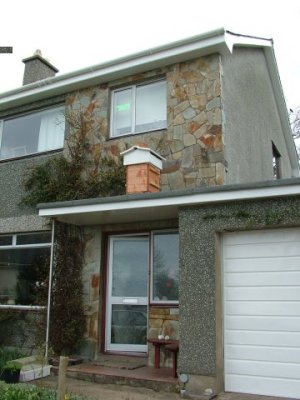
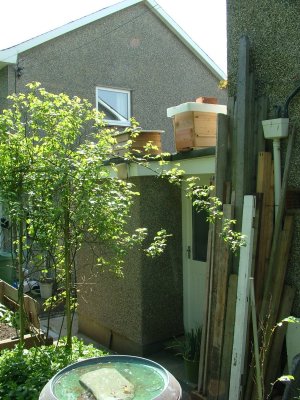
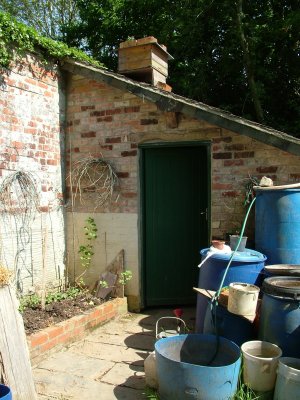
Bait hives (also known as swarm lures or swarm traps)
For Seeley and Morse's criteria for designing bait hives please scroll down to the bottpom of this page.



Left: Warré's 'People's hive', 2 boxes, total 36 litres; middle: Warré & National pattern (40 litres) to left; right: National pattern
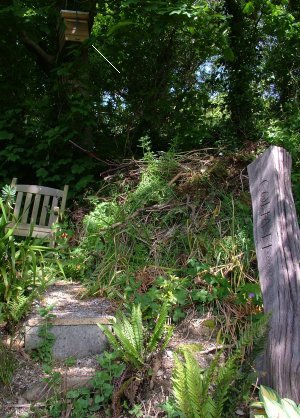
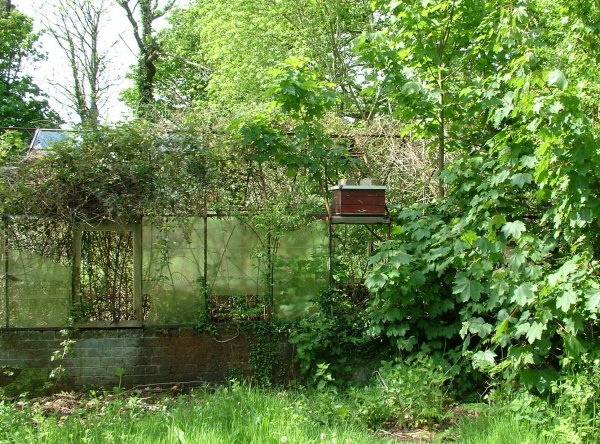
Left: Warré pattern with removable top-bar grid; right: National pattern
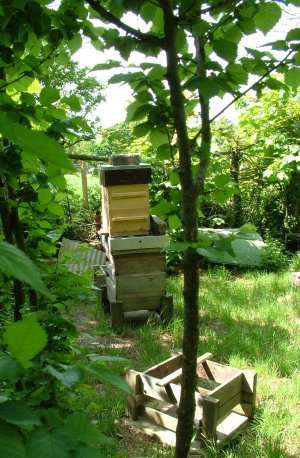
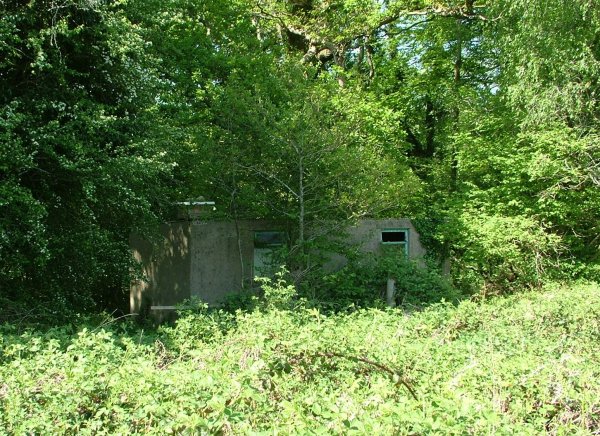
Left: Warré floor, boxes & quilt with National pattern roof; right: National pattern (hive is on top left of building)
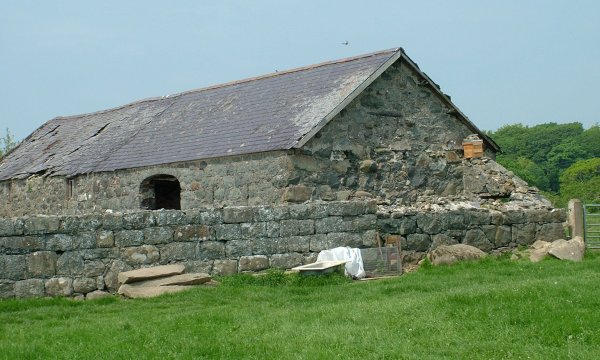
Warré with simple roof.
A light-weight simple and inexpensive bait hive may be made from two large fibre plant pots fixed together with their openings facing one another. Such pots are available at least up to 15 US gallons capacity:
http://www.greenhousemegastore.com/product/fiber-grow-nursery-pot
Purpose built Warré type bait hive
A lighter weight bait hive modelled on the Warré hive has been developed to be more readily transportable. It is also easier to fix to posts or trees. It avoids committing a proper Warré hive to a prominent situation where it is more likely to be stolen. It can be constructed from quite thin plywood. An example of one is shown here.
Disguising bait hives
In some situations it is prudent to disguise bait hives to avoid interference, vandalism, theft etc. Here are some examples by Joe Waggle of disguised bait hives. The first two below are of a cardboard box hidden under a table on a balcony with a table cloth over it.
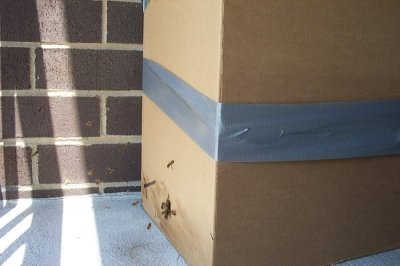
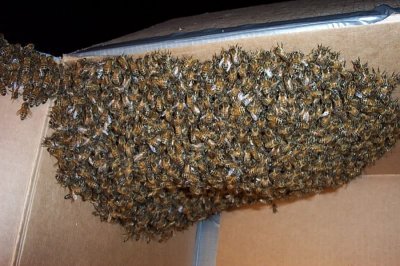
The following is a cabin trunk (foot locker) modified to take a starter-strip board. The bees enter via a hole made in the central catch plate.
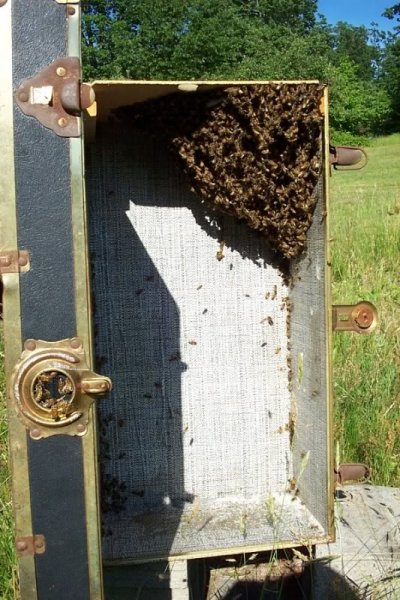
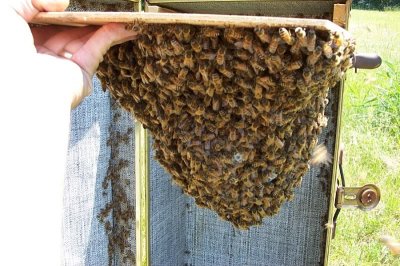
Below left is another cabin trunk example and on the right a traffic cone.
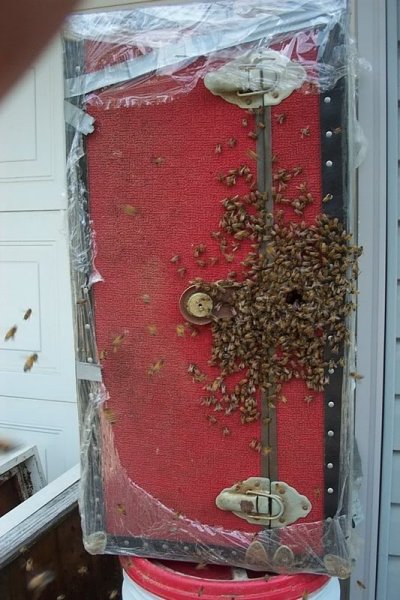
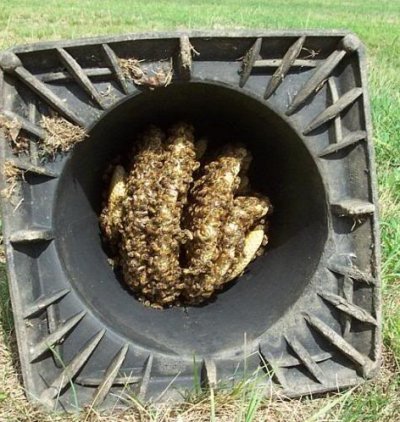
The masterpiece below is a speaker enclosure with the speaker holes blanked out with a board.
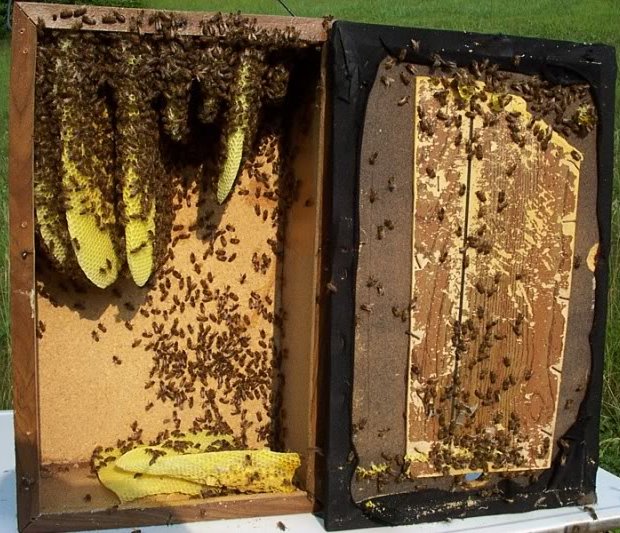
Joe Waggle moderates the Yahoo e-group http://groups.yahoo.com/group/FeralBeeProject/
.
Swarm arriving and having settled at a bait hive
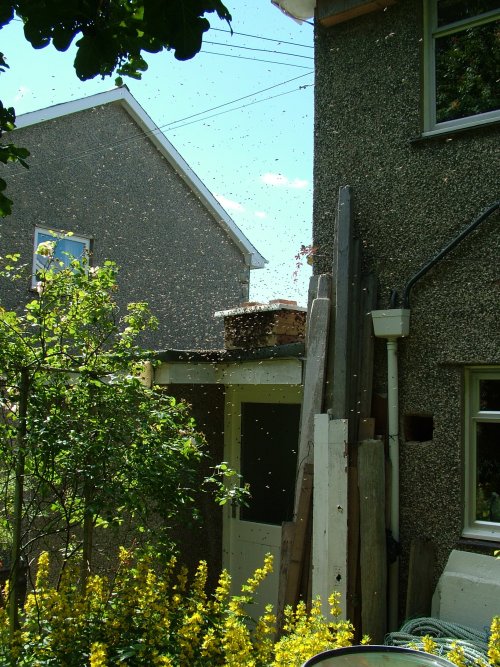
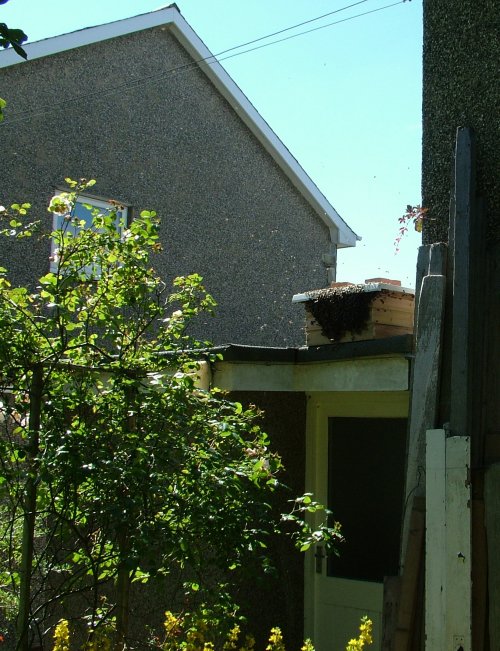
Left: swarm arrives at a National pattern bait hive on 11 July 2007; right: swarm has settled and is entering the bait hive.
This swarm was hived in a Warré later in the day on the same site and then removed to an apiary. The following abstract of a paper by Seeley & Morse (1978) forms the basis of design and positioning of bait hive hives shown on this page. The 'previously inhabitd cavities' is simulated by having something that has been in contact with bees, such as a propolised top-bar cloth, wax starter strips, a propolised crown board or a piece of young empty brood comb from a disease free colony. Bait hives are checked daily in the swarming season and more frequently if scouts are observed. It may help if the bait hive is sheltered from direct early afternoon sun.
Others recommend using a few drops of lemon grass oil in the bait hive to attract scouts. Norman Weston paints the area round the entrance white to increase the contrast and thus make the dark aperture more obvious to the scouts.
One or two bees 'sniffing' around the hive and entering is a sign that it has at least been noticed by a colony. This can happen weeks before a swarm arrives. A dozen or so bees investigating the hive indicates more serious interest. Possibly a nearby colony already has occupied queen cells.
When there are two or more dozens of bees flying around the hive and entering, occasionally feeding each other and making contact by crawling onto and grooming other bees on the exterior of the hive, this can be taken as a sign that a colony is committed to that bait hive. For example, 50 scouts arrived daily to investigate and guard bait hive for more than three days. Other scouts would arrive to provide food for the bees guarding the hive. A swarm took possession of the hive on the forth day. (This paragraph compiled from comments by Joe Waggle to https://uk.groups.yahoo.com/neo/groups/warrebeekeeping/info .)
Swarm entering a bait hive attached to the back of the house in the above photos: https://www.youtube.com/watch?v=Kilk0RjV_U8
Details from a key paper on bait hive design
Nest site selection by the honey bee, Apis mellifera
| Journal | Insectes Sociaux |
| Issue | Volume 25, Number 4 / December, 1978 |
| Pages | 323-337 |
Thomas D. Seeley1, 2 and Roger A. Morse1, 2
| (1) | Museum of Comparative Zoology Laboratories, Harvard University, 02138 Cambridge, Massachusetts, (U.S.A.) |
| (2) | Department of Entomology, Cornell University, 14853 Ithaca, New York, (U.S.A.) |
Summary
| 1. | Honey bees exhibit preferences in several nest site properties. The following preferences were identified («>» means «preferred to»): nest height, 5>1 m; entrance area, 12.5>75 cm2; entrance position, bottom >top of nest cavity, entrance direction, southward>northward; nest cavity volume, 10<40>100 liters. |
| 2. | The data also suggest preferences exist for previously inhabited nest cavities and for nest sites beyond 300 m from the parent colony. |
| 3. | Nest sites with high exposure and visibility were occupied more rapidly than sites with low exposure and visibility. However, this difference probably reflects differential ease of nest site discovery rather than a preference for exposed nest sites. |
| 4. | No preferences were found in the following variables: entrance shape (slit vs. circle), nest cavity shape (cube vs. tall parallelepiped), cavity draftiness (sound vs. drafty), and cavity dryness (wet vs. dry). Cavity draftiness and dryness are probably important to bees, but because bees can seal and waterproof their nests, they may be less demanding about these two nest site variables than about those they cannot modify. |
| 5. | The complex process of nest site selection apparently benefits a honey bee colony in several ways, including facilitation of colony defense and hygiene, simplification of nest construction and microclimate control, and reduction of foraging competition with the parent colony. |
According to Seeley and Morse (1977) the median distance of dispersal of swarms from the parent colony is 300-600 metres. They confirmed Lindauer's earlier findings. The scattergram from their paper is shown below.
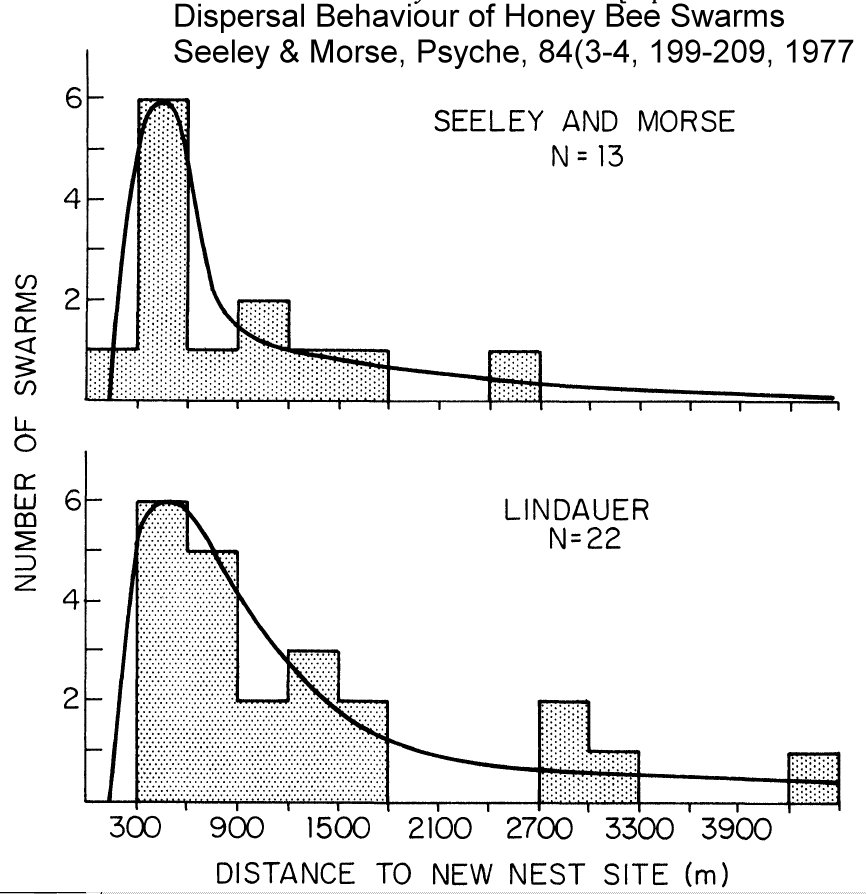
Commercial swarm lure for swarm settling and bait hive attractant
Journal of Apicultural Research Vol. 52 (2)
pp.8-11
DOI 10.3896/IBRA.1.52.2.02
Date April 2013
Article Title: Attraction and direct establishment of primary and secondary honey bee
swarms using swarm-tissue sachets
Authors: Alexandros Papachristoforou and Konstantinos Ilanidis
Abstract
In an effort to attract swarms within an apiary and to induce their direct establishment
in hive-traps, we investigated the use of a new honey bee swarm attractant in the form of
a small sachet containing a wet-wipe tissue, including geranic acid, citral, geraniol and
rose oil as attractants. When swarm-tissues sachets were placed in hive traps at a
distance of either 5 or 30m from the colonies, 60 % of the swarms were established
directly and permanently inside hive traps. All established swarms were secondary, headed
by virgin queen(s). No primary swarm was attracted. When swarm-tissue sachets were placed
in hive traps and were also hung in nearby tree branches, 90.9 % of the swarms were
attracted. Nine primary swarms formed clusters around the swarm attractant sachets while
one secondary swarm was attracted and established directly in a hive trap.
http://www.ibra.org.uk/articles/Attraction-and-establishment-of-swarms-using-lures
Swarm emergence period
This depends very much on the local conditions of latitude, altitude, climate and forage. A record of emergence dates for the author's apiaries in NW Wales, UK is given here (PDF). See also Seeley & Morse's dates for NE USA (PDF).
Videos on the swarming process presented by Tom Seeley
http://www.sciencefriday.com/program/archives/201012245 (link valid on 21 May 2011)
Video of swarm coming to a Warré hive set up as a bait hive
https://www.youtube.com/watch?v=EZBvfFEnuCw
(Jonathan Powell)
References
Seeley, T. D. & Morse, R. A. (1977) Dispersal behaviour of honey bee swarms. Psyche 84(3-4) 199-209.
See also: Seeley, T. D. & Morse, R. A. & Nowogrodzki, R. (1989) Bait hives for honey bees. Information bulletin No. 187. A Cornell Cooperative Extension Publication. Cornell University NY. http://ecommons.cornell.edu/bitstream/1813/2653/2/Bait Hives for Honey Bees.pdf
Papachristoforou, A. & Ilanidis, K. (2013) Attraction and direct establishment of primary and secondary honey bee swarms using swarm-tissue sachets. J. Apicultural Res. 52 (2) pp.8-11.